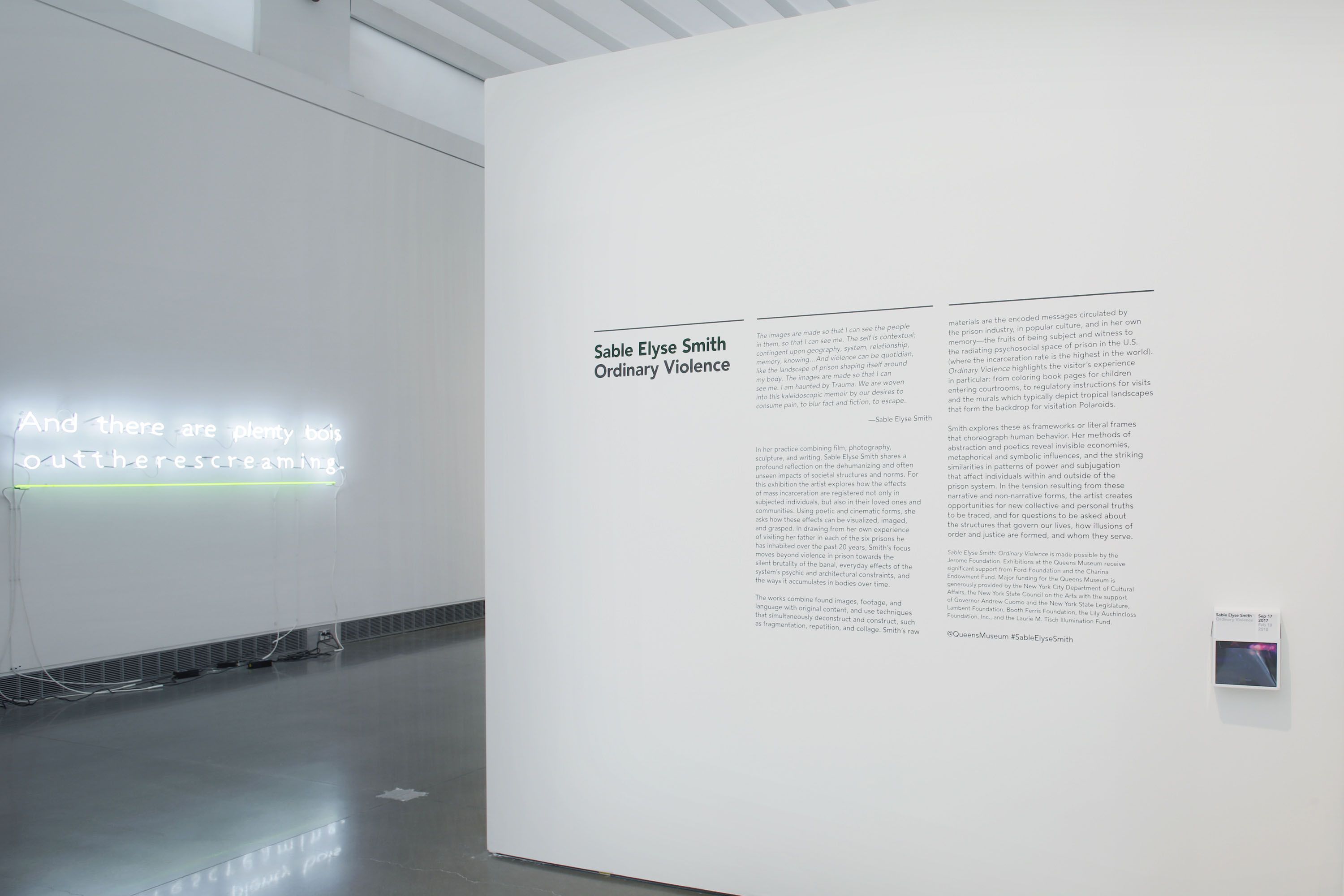
Sable Elyse Smith: Ordinary Violence is the first museum solo exhibition by Smith, a conceptual artist working across film, sculpture, and photography. Her practice explores the many ways that trauma and violence is graphed and marked across bodies. For this exhibition, Smith draws from her own experience of visiting her father in each of the six prisons he has inhabited over the past 20 years in order to question the fictions about the systems and structures that govern our lives, and our illusions of order and justice. Smith examines this habitual violence, and terrors that can hardly be discerned, and asks how it can be visualized, imaged, and grasped.
In her photographic works, Smith explores the ways in which multiple modes of image making and production promote or refute common narratives of incarceration. In a series of works including 7665 Days (2017), Smith manipulates Polaroid photos of family members taken in visitation rooms that are set against a painted mural; these Polaroids are among the most prominently visible and highly distributed types of images of the prison experience.
In these works, Smith further addresses the unspoken economy and negotiation embedded in the creation and circulation of these images. Typically depicting tropical landscapes, the murals are painted by the inmates themselves, most of whose labor is unpaid. These Polaroids cost USD 2-4, which must be purchased by federal inmates (visitors are not allowed to make the purchase) who typically earn between 12 - 40 cents per hour.
In this way, the paintings are repeatedly commodified and occupy a slippery space between public art and private art. Very tender, personal moments that take place in front of them feel choreographed by and sharply contrasted with the strict code of conduct that governs the visitation, which are enacted by a number of agents: muralist, guard, photographer, camera, visitor, inmate receiving a visit, inmates not receiving a visit, and the room of spectators.
“The mural is a ubiquitous art form within the walls of prison. Besides popular imaging of prison and jails in the dominant media landscape, the intimacy performed (between the incarcerated individual and their visitors) in front of a visiting room mural is the second most iconic representation of prison in the United States,” says Smith, who is interested in the production of these images and the immaterial labor embedded in them, in relation to the many and varied ways prison is visualized.
Many of her works address how the system of incarceration impacts personal and collective psyches, registering its effects through bodily experience. A nine-channel video that resembles a surveillance tape, Untitled: father Daughter Dance (2013-2017), comprises a juxtaposition of found footage of an arrest, and video of Smith performing the choreography that occurs during the visitation such as emptying pockets, stepping through magnetometers, and being searched.
Smith maps the performances that occur within the bounds and mandates of the prison sphere, inflicting their silent brutality that begins well before one enters the visiting room, and extend well beyond it. In two other videos, Men Who Swallow Themselves in Mirrors (2017) and How We Tell Stories to Children (2015), Smith employs fragmented cinematography and soundscapes, building up layers of imagery to achieve a silent poetic, and rendering a beauty in the brutal. She marries original and appreciated footage, ranging from familiar images of urban streets, to a clip from Charles and Ray Eames’ documentary Powers of 10 (1977), in a collage at once connecting us to her personal experience and the implicit, but radiating psychosocial milieu of the prison industrial complex. The artist’s largest sculpture to date also features in the exhibition, a large white and green neon entitled Landscape I (2017), which spells out the sentence “And there are plenty bois out there screaming.” Rather than point to familiar narratives of violence of the US prison system, Smith’s interest in portraying violence and trauma exists in the banal, everyday effects that are accumulated in bodies over time.

neon
20.5 x 96.5 in
52 x 245 cm


screen printing ink, oil pastel, graphite, and oil stick on paper
60 x 50 in
152.5 x 127 cm

screen printing ink, oil pastel, graphite, and oil stick on paper
60 x 50 in
152.5 x 127 cm



digital c-print with custom suede mat
48 x 40 in
122 x 101.5 cm

digital c-print with custom suede mat
48 x 40 in
122 x 101.5 cm

acrylic
30 x 20 in
76 x 51 cm



video
8:32 minutes